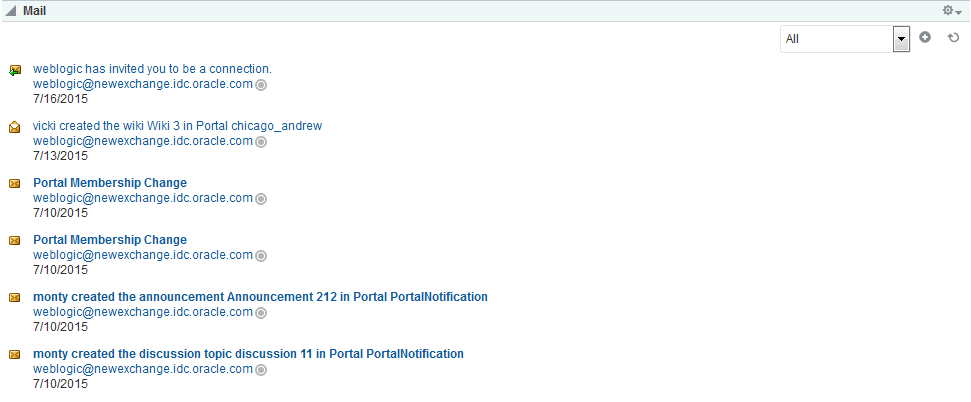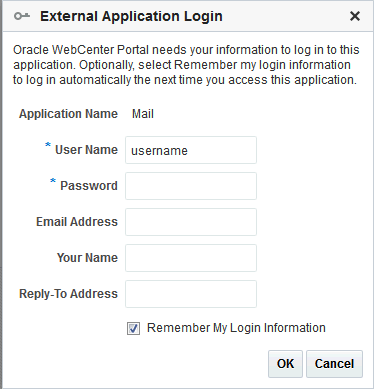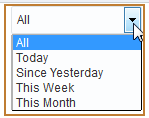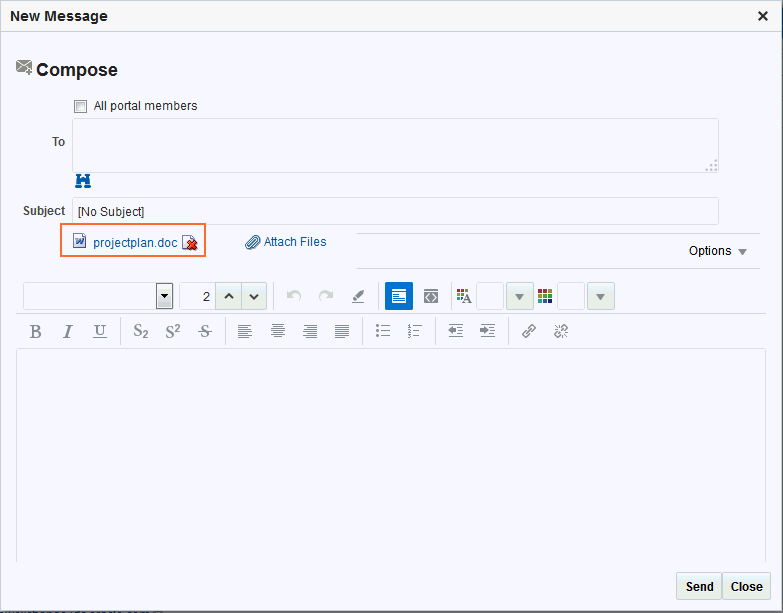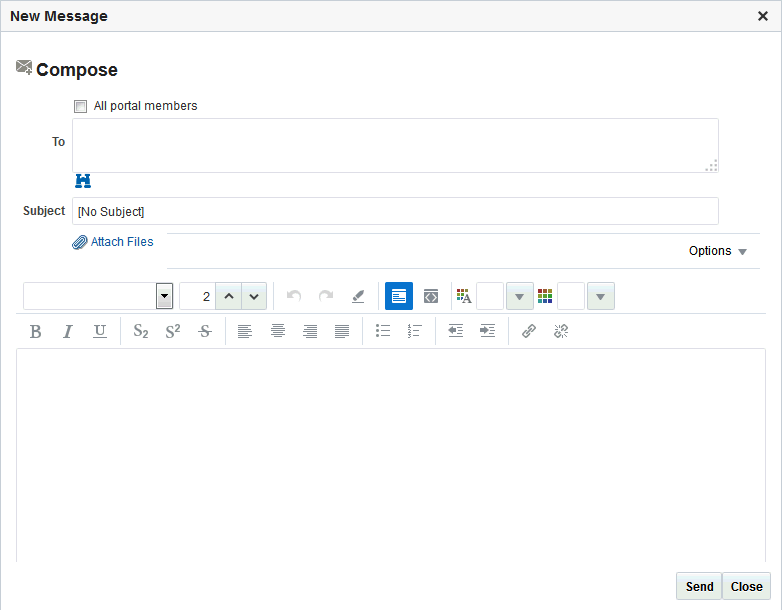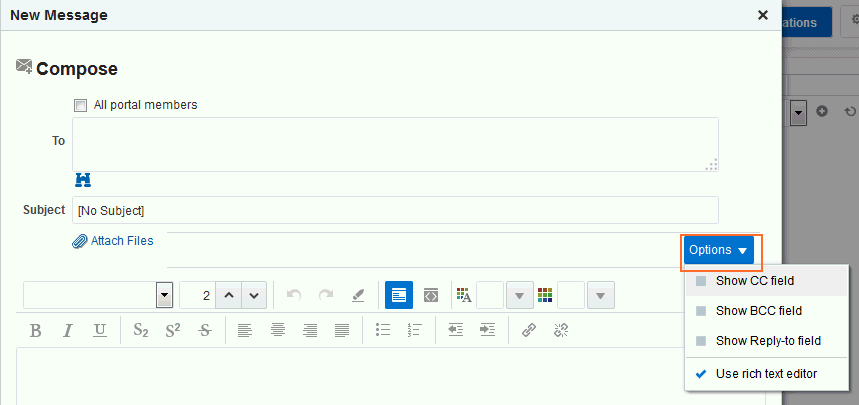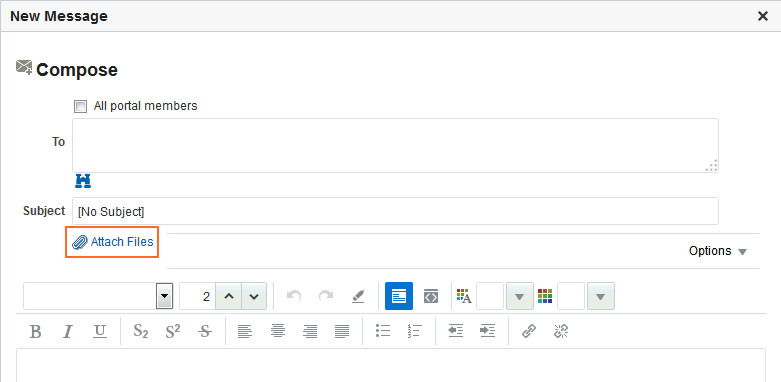12 Sending and Viewing Mail
Send and view mail from a portal using WebCenter Portal’s Mail service or your local mail client.
Permissions:
To perform the tasks in this chapter, you must be granted at least the portal-level permission View Pages and Content to view mail. You can view mail only for assets for which they have view permission.
Authenticated users require the portal-level permission Customize Pages, and must have view permission on the resource.
Note:
Some of the tasks discussed in this chapter are not available if mail is not configured. Portal managers can add the Mail viewer to a portal, as described in Adding Mail to a Portal in Oracle Fusion Middleware Building Portals with Oracle WebCenter Portal.
Topics:
12.1 About the Send Mail Feature
Throughout WebCenter Portal, you can click the Send Mail icon (Figure 12-1) to mail directly from another feature, such as announcements (Figure 12-2). You need to have the required permissions to work with the other features in order to use the Send Mail feature from the feature.
Figure 12-1 Send Mail Icon
For example, Figure 12-2 shows an announcement topic with the Send Mail icon.
Figure 12-2 Send Mail Icon in an Announcement

Description of "Figure 12-2 Send Mail Icon in an Announcement"
Click the Send Mail icon to open a mail compose window prepopulated with information including the announcement topic title, author, date created, topic text, and links to the announcement and the portal. You can edit and add to the mail, as necessary.
Note:
To use WebCenter Portal's Send Mail (not your local mail client), you must change the mail preference (see Selecting Your Preferred Mail Connection). If you are using your local mail client, you are required to log in to mail if you are not logged in (see Logging in to Mail). Log out and then log back in to WebCenter Portal after you change your preferences.
Figure 12-3 WebCenter Portal Mail Compose Window From an Announcement
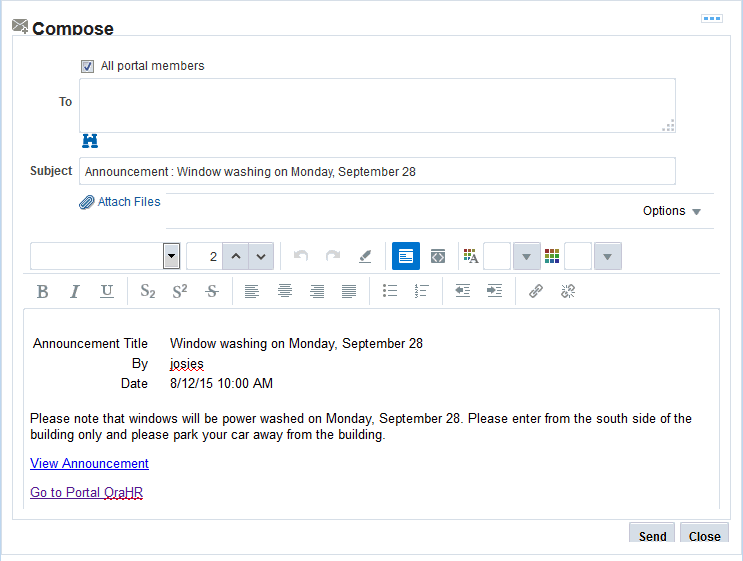
Description of "Figure 12-3 WebCenter Portal Mail Compose Window From an Announcement"
The way the mail window is prepopulated depends on the asset sending it. For example, from a wiki, Send Mail opens a mail window prepopulated with the name of the wiki, the size, who created it and when, who modified it and when, and a URL link to the wiki.
Mail, is by default, addressed to all members of the portal. Portal managers can configure the distribution list.
Tip:
With the Microsoft Outlook local mail client, you must configure Outlook to support comma-delimited mail addresses.
12.1.1 Configuring the Send Mail Feature
The Send Mail feature does not require the mail service to be configured. That is, even if mail has not been configured in WebCenter Portal, the Send Mail feature is available using WebCenter Portal's Mail service.
Your system administrator determines the mail client that the Send Mail feature uses: either WebCenter Portal's Mail Service or a Local Mail Client. The default value is Local Mail Client. If your system administrator enabled users to override this mail client setting, then you can select a different mail client on the Preferences - Mail page (Figure 12-4).
See Selecting Your Preferred Mail Connection for more information about setting mail preferences.
12.2 About Mail in WebCenter Portal
WebCenter Portal conveniently exposes familiar mail functionality. Mail is managed on the same mail server that provides your regular business mail, and the mail messages exposed are the same messages you would see in your mail inbox. Many of the same actions are also supported. For example, you can send messages with attachments, forward messages, and so on. The mail feature does not replace your company mail, but rather enhances it by making it accessible within WebCenter Portal.
WebCenter Portal's Mail service enables users to perform simple mail functions, such as view, read, create and create with attachments, reply, forward, and delete. All mail is stored in your inbox and can be accessed from there through a link.
WebCenter Portal fetches mail from the inbox folder only. It does not support fetching mail from other folders or moving messages. It supports any mail server based on IMAP4 and SMTP protocol. WebCenter Portal provides access to multiple mail connections. You can use a different mail connection by selecting it in WebCenter Portal's Preferences settings. For more information, see Selecting Your Preferred Mail Connection.
The Mail viewer exposes features from your mail server (Figure 12-5).
The Mail viewer presents the following:
-
A menu for specifying which messages to display
-
A Compose icon for starting the process of creating a new message
-
A Refresh icon for updating new messages
Note that the mail viewer does not render embedded images. If an email contains inline images, they are shown as attachments, and not within the message body.
A default distribution list containing all the portal members is created upon portal creation. The portal manager can also select a different distribution list. As members are added to or deleted from the portal, the mailing list is updated automatically.
You can mail other users or any user recognized by the back-end mail server by adding their mail addresses in the To field.
Mail is integrated with WebCenter Portal's instant messaging and presence to provide additional options for contacting others. Each listed mail message in the viewer includes the sender's user name and status icon, which you can click to open a menu with options for starting a chat session or sending a new mail.
Note:
If instant messaging and presence is not configured in WebCenter Portal, the status icons are grayed out. For more information, see Using Instant Messaging and Presence Viewer.
12.3 Selecting Your Preferred Mail Connection
When WebCenter Portal provides access to multiple mail connections, it also provides a way for you to choose which connection to use.
Note:
You can choose your preferred mail connection only if your system administrator enabled users to override this mail client setting.
12.4 Working with Mail
WebCenter Portal's mail feature exposes your company's mail features within the context of your portal. You can view, respond to, and manage your personal mail.
This section provides information about how to use mail in WebCenter Portal. It includes the following topics:
12.4.1 Logging in to Mail
If you are using your local mail client, before you can access your mail in a portal, you must provide your mail login credentials. The first time you access mail, it displays the message depicted in Figure 12-7.
To log in to mail:
12.4.2 Personalizing Your View of Mail
You can personalize your view of the mail by filtering the number of displayed messages. For example, you can choose to display only the messages that were delivered Today, Since Yesterday, This Week, or This Month. Additionally, you can choose to display All messages in your inbox.
Note:
By default, the 50 most recent mail messages from your mail server inbox folder are displayed.
Personalizations affect only your view of mail. No other user's view is changed because of your selection.
To personalize your view of mail:
12.4.3 Opening Mail Messages
The messages that display in your mail are the same messages that display in your regular mail application inbox. You open them in the same way too. Note that the mail viewer does not render embedded images. If an email contains inline images, they are shown as attachments, and not within the message body.
To open a mail message:
- Click the link to the message you want to open.
- After reading the message, click Cancel to close the message.
Note:
HTML reports, tables, inline images (copy paste), and fonts viewed in a mail message may not render correctly. The Mail service requires HTML data to be well-formed to display as expected in a mail message.
The mail should show everything that your browser supports. However, some tags, like <script>, are encoded and disabled from execution.
12.4.4 Downloading Mail Attachments
Note that the mail viewer does not render embedded images. If an email contains inline images, they are shown as attachments, and not within the message body. Attachments display in mail messages as links (Figure 12-10).
Accessing files associated with attachments is the same as accessing a file from any browser window.
To view an attachment, click the link. Clicking an attachment link opens a download dialog that gives you the option of viewing the file in its native application or saving the file to a locally. This is browser behavior, so the behavior depends on the browser you use.
12.4.5 Composing and Sending Mail Messages
Whether you are composing and sending messages through WebCenter Portal's Mail or using your local mail client, it is the same as doing so in your regular mail application.
To compose and send a mail message:
12.4.6 Sending Mail with Attachments
Just like your regular mail, you can send messages with attachments.
To send a mail with attachments:
12.4.7 Removing Attachments from the Add Attachment Window
You can remove attachments from the Add Attachment window and from the Compose window:
-
To remove mail attachments from the Add Attachment window, click the Remove Attachment icon next to the attachment you want to remove (Figure 12-17).
Figure 12-17 Remove Attachment Icon in the Add Attachment Window
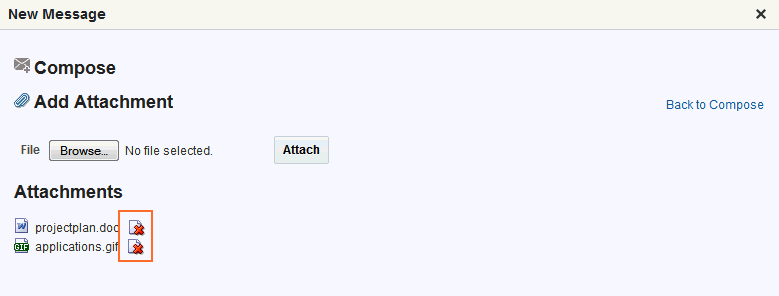
Description of "Figure 12-17 Remove Attachment Icon in the Add Attachment Window"For information about accessing the Add Attachment window, see Sending Mail with Attachments.
-
To remove mail attachments from the Compose window, click the Remove Attachment icon next to the attachment you want to remove (Figure 12-18).
Figure 12-18 Remove Attachment Icon in the Compose Window
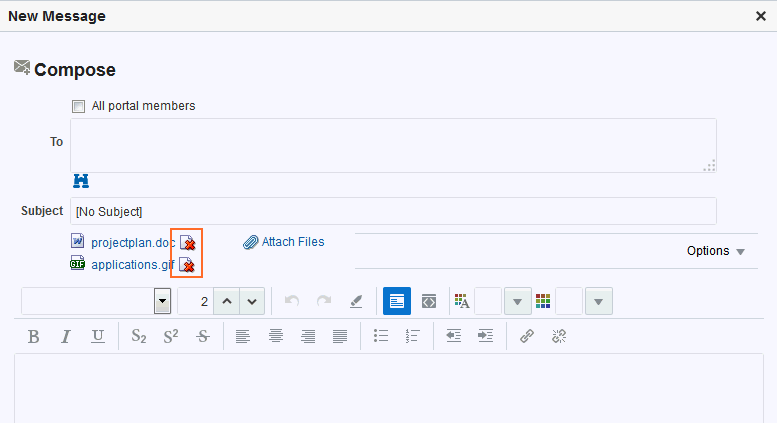
Description of "Figure 12-18 Remove Attachment Icon in the Compose Window"For information about accessing the Compose window, see Composing and Sending Mail Messages.
12.4.8 Replying To and Forwarding Mail
When you reply to or forward a mail message, the mail content is sent as an attached HTML file instead of being displayed in the mail message window. Replying to and forwarding mail is as straightforward as in your regular mail application.
To reply to or forward a mail message:
12.4.9 Refreshing Mail
You must refresh to check for new mail messages. Because the refresh operation triggers an event to the server to check for new mail, it may take a while to get new messages. Therefore, you may have to refresh a couple of times or so to display new mail.
-
To refresh mail, click the Refresh icon (Figure 12-19).
Note:
Do not click the Reload or Refresh button in your browser. Click the Refresh icon to update your view.

